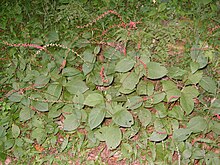Persicaria filiformis
| Persicaria filiformis | |
|---|---|

| |
| In Korea | |
| Scientific classification | |
| Kingdom: | Plantae |
| Clade: | Tracheophytes |
| Clade: | Angiosperms |
| Clade: | Eudicots |
| Order: | Caryophyllales |
| Family: | Polygonaceae |
| Genus: | Persicaria |
| Species: | P. filiformis
|
| Binomial name | |
| Persicaria filiformis | |
| Synonyms[1] | |
| |
Persicaria filiformis is a species of flowering plant in the family Polygonaceae, native to the Kuril Islands, Japan (including the Ryukyu Islands), Korea, Myanmar, the Philippines and Vietnam.[1] It was first described as Polygonum filiforme in 1784 by Carl Thunberg and transferred to the genus Persicaria in 1819 by Takenoshin Nakai.[2] The species has been treated as the variety filiformis of Persicaria virginiana, a North American species.[1]
-
Form with marked leaves
References
- ^ a b c d "Persicaria filiformis (Thunb.) Nakai", Plants of the World Online, Royal Botanic Gardens, Kew, retrieved 2019-05-03
- ^ "Plant Name Details for Persicaria filiformis (Thunb.) Nakai", The International Plant Names Index, retrieved 2019-05-03

